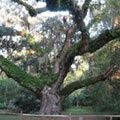
my cloth drying on a saw palmetto plant
I attended a workshop at The Coastal Discovery Center in the Honey Horn Plantation Preserve of Hilton Head given by Karen Hall of Clemson University. What fun.... there were at least 25 crafts persons attending, most dressed in some form of indigo! (blue jeans)... We all made a decorated cloth and hung it to dry while taking a walk to Honey Horn's indigo garden. A very unimpressive plant... looks like a big weed! So now I'm on the lookout for this growing wild but bought seeds at the gift shop just in case.

other designs (most tie dyed)

indigo dyeing under live oaks, hanging Spanish moss and palmetto palms


No comments:
Post a Comment